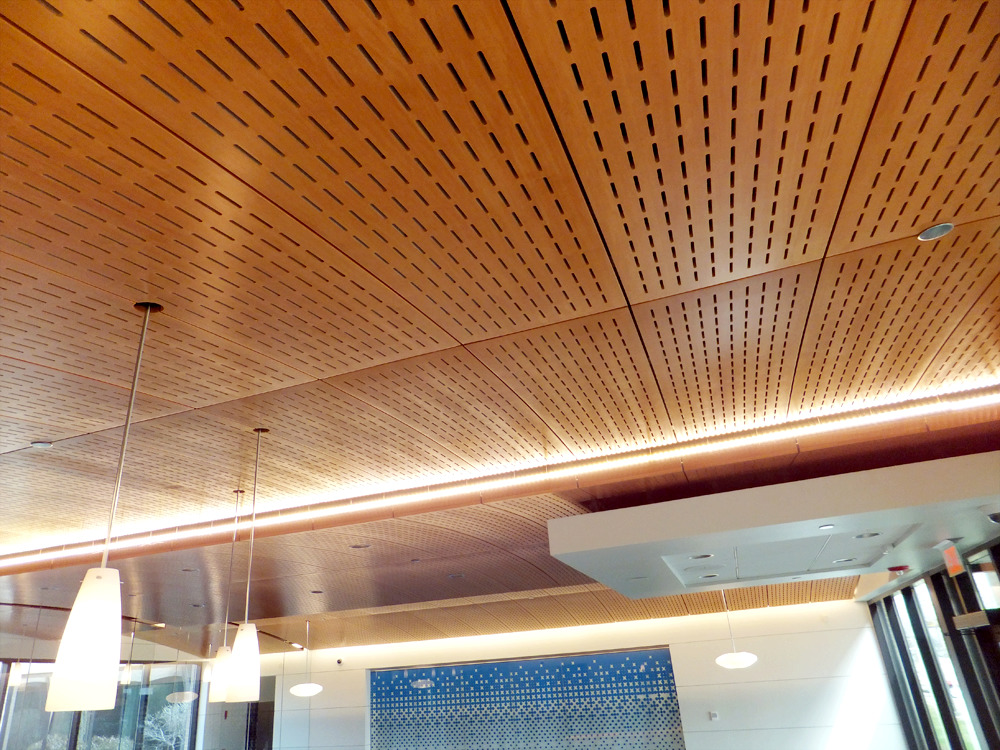
Ceilings are an incredibly important part of any design aesthetic. They often provide the largest interrupted space in the room, and their height and design can drastically alter the feel of the space. As important as they may be, many of us pay very little attention to these dynamic design elements. Many of us don’t even know where to start.
For instance, do we want conventional or exposed ceilings? How high or low do we want to go? What kind of textures and colors would we like to incorporate? Every combination of these elements will deliver a different vibe. If the ceiling is in a place of business, the specific combination you choose can even affect your employees ability to efficiently do their jobs or for your guests to fully enjoy their visits.
Before you make this space-defining decision, it’s incredibly helpful to familiarize yourself with what each element means both aesthetically and acoustically. Today, we’ll dig into exposed ceilings. What they are and what makes them a good or bad choice for your space. Let’s go.
What is an exposed ceiling?
An exposed ceiling is pretty much exactly what the name implies. The overhead structure is visible with the naked eye. You’ll see all the ductwork, trusses, and pipes that traverse the overhead space. The overall result depends largely on how well these open ceilings are done.
Well executed exposed ceilings usually incorporate these structural elements in a creative way that provides far more visual appeal than a conventional ceiling usually does. They also give us more height. On the other hand, they can get a bit noisy if not finished correctly. There are a number of pros and cons worth considering prior to making your decision.
Residential vs Commercial Ceilings
If you’re wondering whether or not exposed ceilings will work for your space, don’t worry. Exposed ceilings can work equally well in residential and commercial spaces. It all depends on the overall aesthetic you’re going for. Exposed ceilings are popular options in residential and artist lofts, however, when it comes to exposed ceilings commercial spaces reap the biggest benefits. Here’s why.
Many people are looking to build cozy nests in their homes, and exposed ceilings don’t necessarily fit that bill. While they are aesthetically pleasing, many people prefer cozier options. In the workplace, we’re looking for the exact opposite. We want a cool and open space to contribute to a productive work environment. In a world where many in management are doing their best to get workers to return to the office, an open ceiling office may offer incentive.
In order to get all you want out of this type of ceiling, you’ll need to do some planning. If you skip this step, you’ll likely encounter issues ranging from a noisy office to increased energy consumption. Looking at the advantages will help you make your decision, but looking at the disadvantages will allow you to plan ahead and avoid the pitfalls that could cause problems. Let’s explore.
Advantages of Exposed Ceilings
There are a lot of upsides that go along with exposed ceilings. Aside from providing a trendy industrial open ceiling design, there are a number of practical reasons people choose to go with exposed ceilings. We’ll start by covering some of the most compelling upsides.
They Make the Room Appear Larger
Adding a few extra feet to the height of your ceilings can make the space look considerably larger. That keeps the room from feeling cramped. Since cramped spaces can contribute to stressful feelings, utilizing exposed ceilings in your interior designs can help keep employees calm and productive. As a retail ceiling design, it can even provide more wall space for displaying your wares. Adding the illusion of a larger room is a win win.
They Allow Heat to Rise
Since an exposed office ceiling adds height to the room, that extra overhead space allows heat to rise. You’ll likely save some money on summer cooling costs by going with exposed ceilings.
In work spaces, this can even lead to increased productivity. When spaces are too warm, they can make us feel uncomfortable and less focused. Bringing fans into the equation only introduces excess noise and wind that can blow papers around. Keeping the space cool with exposed ceilings is a great way to quietly keep the interior climate more comfortable.
On the other side of the coin, your heat will rise in the winter. Making sure you’ve got a robust air circulation system will help out a lot.
They Provide More Lighting Options
Another big benefit associated with high, exposed ceilings is that you’ve got more lighting options to work with. With lower ceilings, your options are much more limited. You’ll either have to set the lighting into the ceiling or suspend it deep into the room. This can cause problems getting great lighting to certain areas and can break up lines of sight.
With open ceilings design can be whatever you want it to be. You have a much greater range of depths at which they can be suspended without interfering. Lower ceilings do reflect more light than exposed ceilings, but a little light reduction is easily solved by proper placement.
If you decide to use baffles or ceiling clouds to address acoustical issues, you can even drop lighting through the gap to deliver light wherever it’s needed. This provides proper illumination while adding depth and visual pop to the entire space.
Disadvantages of Exposed Ceilings
With all those pros, it’s an unfortunate fact of life that exposed ceilings do come with some drawbacks. If you choose to go with an exposed ceiling, you’ll want to take each of these items into consideration. Fortunately, many of them come with solutions that can help you solve them without sacrificing the industrial design ceiling aesthetic you’re building.
They Can Cause Acoustical Issues
Since pretty much everything overhead is going to be made up of hard, reflective materials, acoustics can become an issue with untreated exposed ceilings. You’re going to want to incorporate absorptive materials, and there are a few ways to do that.
Baffles
One great way to tackle the acoustic issues associated with exposed ceilings is to use baffles. Baffles are suspended planks of wood that create design elements that are very conducive to great acoustics. The type of design you choose will influence the feel of the room in a big way.
For instance, linear baffles can add visual length to the room. Choosing something with cubes or other geometric shapes creates texture and modern design elements. Consulting with a professional is the best way to get the look you’re after with materials that will solve acoustical issues. Add an acoustical backing and you’ll have a hard time believing this type of exposed industrial ceiling ever had any sound issues at all.
Acoustic Panels
If you’re not familiar with acoustic panels, they are the go-to option for eliminating acoustical issues and making rooms sound better. They are made of high density, porous materials that allow sound waves to pass into them, but not out. They are particularly effective against high and mid frequencies, which makes them perfect for living and working spaces alike.
Ceiling Clouds
Ceiling clouds are another type of acoustic panel that is suspended from the ceiling by wires. There are a few fantastic reasons for choosing this option to treat an open duct ceiling. First, they look great. You can add a pop of color, an interesting print, or any combination of panels to make the ceiling your own. Second, they absorb a good deal of sound. Whether that sound is coming from overhead mechanical, electrical, and plumbing (MEP) systems or the chatter below, ceiling clouds prevent the sound waves from reverberating up and down.
They Can be Hard to Clean
Since everything overhead in these stunning modern office ceilings is exposed, they are prone to gathering dust. Also, their height can make cleaning that dust problematic. Your best bet to avoid a lot of maintenance and cleaning is to use a paint that hides dust well.
Not only will the paint minimize the appearance of dust and dirt, but they’ll protect your MEP systems as well. Keeping them well protected will save you a bundle in repairs down the road.
They’re Not as Low Cost as They May Seem
Since you’re leaving all the MEP systems exposed, many people believe exposed ceilings are a bargain basement option. While you could simply remove your drop ceiling and call it a day, you may want to think hard before going that route. You need to finish it well if you want it to provide the modern look you’re after with the acoustical treatments that will keep it inviting.
While doing exposed ceilings right won’t be the cheapest option out there, they’re certainly not the most expensive. Working with a professional firm will get you the results you want without purchasing unnecessary materials. We can even help with the installation logisticsl and make sure you know what you’re getting into before you start.
If you love the look, there are great reasons to invest in this type of modern ceiling design for office spaces. You’ve simply got to invest some time in proper planning to protect your investment before you begin.




